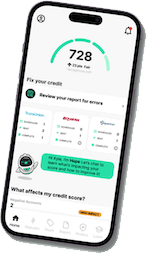My Credit Score Dropped 60 points for No Reason

Seeing a sudden drop in your credit score can be frustrating—especially when it happens without warning. But credit scores don’t change at random. Whether it’s a late payment, increased credit utilization, or a new negative item on your report, there’s always a reason behind the decline. This guide breaks down the most common causes of a score drop, debunks common myths, and offers actionable steps to help you recover quickly.
You wake up, check your credit score, and—boom—60 points gone. Not just a few points. No warning. No obvious reason. Just a gut-punching drop that leaves you scrambling for answers.
Before you panic, take a deep breath. Credit scores don’t drop at random—there’s always a reason even if not immediately visible. The key is figuring out what happened and how to fix it fast.
Let’s break down the top reasons your credit score might have plummeted and what you can do to recover.
Top 5 Reasons For Drops
1. Missed or Made a Late Payment
Payment history makes up 35% of your credit score. Even one late payment (30+ days past due) can cause a major drop. If you missed a payment, contact your lender to see if they can offer a grace period or remove the late mark.
2. Credit Utilization Ratio Increase
The amount of credit you’re using relative to your total limit, known as your credit utilization ratio, can have a major impact on your credit score. If your ratio jumped past 30%, you might see a drop. Aim to keep utilization below 10% for the best credit scores.
Lenders sometimes lower credit limits based on your spending habits or overall economic conditions. If your credit limit decreases but your balance remains the same, your utilization ratio increases, which can lower your credit score.
3. Applying For or Opening New Credit Accounts
Applying for a new credit card or loan triggers a hard inquiry, which can slightly lower your credit score. Opening multiple accounts in a short period can have a larger impact by reducing your average credit age.
4. Closing a Credit Account
Closing a credit card reduces your total available credit, which can raise your utilization ratio. Similarly, paying off a loan can slightly lower your credit score because it reduces your credit mix and the number of active accounts. This can occur whether it is a mortgage or auto loan that is paid off.
5. New Negative Account
A collection, charge-off, repossession, or bankruptcy on your credit report can cause a significant drop. Even small debts sent to collections can have a big impact. If you notice a new negative account, you may want to dispute it if it’s inaccurate.
How Often Do Scores Drop?
Everyone experiences credit score changes at some point. Here’s what’s normal:
- Minor fluctuations (5–20 points) happen regularly due to normal credit activity, like balance changes or new inquiries.
- Larger drops (20–50+ points) are less common but typically occur after missing your payments, high utilization, or a negative item being reported.
- Significant drops (50–100+ points) are rare and usually tied to serious credit events like missing your payment, collections, or bankruptcy.
Even responsible credit users experience occasional drops due to credit report updates, scoring model changes, or closing old accounts. If your score changed unexpectedly, reviewing your latest credit report can help you understand why.
Common Myths About Score Drops
Many people panic when they see their score decrease even a few points, but not all assumptions about credit score fluctuations are true. Let’s debunk some common myths:
- Myth #1: Checking Your Own Credit Lowers Your Score
Soft inquiries, like checking your own credit report, have no impact on your credit score. Only hard inquiries from lenders reviewing your credit for new accounts can cause minor drops. - Myth #2: Closing Old Accounts Improves Your Score
Closing an old credit account can actually lower your credit score by reducing your available credit and shortening your credit history. Keeping older accounts open helps maintain a strong credit score. - Myth #3: Paying Off a Loan Always Increases Your Score
While paying off debt is great for financial health, closing a loan can sometimes slightly lower your credit score by reducing your mix and number of active accounts. - Myth #4: A Dropped Score Means You Did Something Wrong
Credit scores can drop even when you haven’t made a mistake. Credit utilization changes or old accounts aging off your report can cause unexpected fluctuations. - Myth #5: Disputing an Item Will Instantly Remove It
While disputing credit report mistakes can improve your credit score if successful, not all disputes result in removal. Credit bureaus investigate claims, and valid negative items will remain.
Understanding these myths can help you make smarter credit decisions and avoid unnecessary stress over temporary credit score changes.
How to Identify Why Your Score Dropped
If your score changed and you don’t see an obvious reason, follow these steps to find out why:
1. Check Credit Report for New Negative Items
Review your latest credit report for:
- Missing Your Payments – Even a single missed payment on your credit history can cause a major drop.
- New Hard Inquiries – Applying for new credit can slightly lower your credit score.
- New Collections or Charge-offs – Recently reported negative accounts can have a big impact.
2. Look for Balance Changes
- Higher Credit Utilization – Even if you didn’t max out your credit card account, an increase in your balance-to-limit ratio can drop your score.
- Closed Accounts – If you recently closed a card, your overall available credit decreased, affecting utilization.
3. Check for Account Changes
- Aging of Accounts – If an old account fell off your report, your average credit age may have decreased.
- Paid-Off Loans – Paying off a loan can slightly lower your credit score by reducing your mix.
4. Verify Credit Report Updates
- Different Credit Bureau Reporting – Not all lenders report to every bureau. Check if a change is reflected on all three credit reports with Experian, Equifax, or TransUnion.
- Errors or Fraud – An unexpected drop could indicate incorrect information or identity theft.
5. Check for Score Model Differences
- Your credit score may vary depending on the model used (FICO vs. VantageScore) or industry-specific scoring (auto, mortgage, etc.).
6. Wait for Temporary Drops to Rebound
- Large Purchases or Balance Reporting Dates – If you recently made a large purchase, your score might temporarily dip before rebounding once your balance updates.
Understanding Credit Scores
When trying to figure out why your score changed, it helps to understand how credit scores work and what affects them. Lenders use your credit score to determine how risky it is to lend to you. A higher score means better interest rates, easier loan approvals, and more financial opportunities.
Seeing Different Scores
Your credit score can vary depending on where you check it. Lenders use different models—like FICO® and VantageScore®—and may pull reports from different national credit bureaus. Since each bureau updates data at different times, your score may fluctuate. Here’s the difference between FICO® and VantageScore®.
| Factor | FICO® Score 📊 | VantageScore® ⚡ |
|---|---|---|
| Score Range | 300 – 850 | 300 – 850 |
| Missed Payments | Affects score more if recent & frequent | More sensitive to a single event |
| Credit Utilization | Reports based on statement balance | More sensitive to short-term spikes |
| Credit Inquiries | Ignores multiple mortgage/auto loan inquiries within 45 days | Uses a 14-day window for similar inquiries |
| Credit Age | Emphasizes older accounts | Considers both old and new accounts more evenly |
| New Accounts | Can cause a temporary drop | May have a bigger impact on new borrowers |
Credit Score Factors:
Your score is also based on five key factors but the factors might vary slightly depending on the model used.
Here’s the 5 key factors:
- Payment History (35%) – The most important factor. Missing or making your payments late can drop your score significantly.
- Credit Utilization (30%) – This is the amount of available credit you’re using. Staying under 10% is ideal, while anything above 30% can lower your score.
- Credit Age (15%) – The longer your credit history, the better. Closing old accounts can shorten your average age and drop your score.
- Credit Mix (10%) – A mix of credit cards, loans, and mortgages can help your score by showing responsible credit management.
- New Credit & Inquiries (10%) – Applying for too many new accounts at once can signal financial distress and temporarily lower your score.
By keeping these factors in check, you can maintain a strong credit score and avoid unexpected drops.
How to Recover from a Decrease (and Increase It Over Time!)
A decrease can feel discouraging, but don’t panic—there are steps you can take to bounce back quickly and even improve your credit score in the long run.
Step 1: Identify the Cause of the Drop
Before you can fix your score, you need to know why it dropped. Use a credit monitoring tool (like Dovly!) to check for:
✅ Late or missed payments
✅ Increased credit limit utilization
✅ New inquiries or accounts
✅ Errors or fraud on your credit report
Once you identify the issue, you can take action to start recovering.
Step 2: Quick Fixes to Boost Your Score
1️⃣ Pay Bills on Time (Every Time!)
- Payment history is 35% of your score—Missing even one payment can hurt for months.
- If you missed a payment, pay it ASAP—the longer it goes unpaid, the worse the impact.
- Set up autopay or reminders to avoid missing any payments in the future.
2️⃣ Lower Your Credit Utilization
- Try to keep your credit utilization below 10%—anything above 30% can hurt your score.
- Pay down balances strategically, starting with the highest-utilized cards first.
- Ask your credit card issuer for a credit limit increase—this instantly improves your utilization as long as you don’t spend more!
3️⃣ Avoid Opening Too Many New Accounts at Once
- Inquiries from multiple applications can drop your score (especially in a short period).
- Only apply for new credit when absolutely necessary.
4️⃣ Dispute Any Errors on Your Credit Report
- If you find incorrect payment history, accounts you don’t recognize, or duplicate listings on your credit report, dispute them ASAP.
- Services like Dovly can help automate dispute processes and improve your credit score faster.
5️⃣ Don’t Close Old Credit Accounts
- Closing an old account reduces your available credit and can lower your credit age—both of which can drop your score.
- Instead of closing unused cards, keep them open with a small recurring charge (like a subscription) to maintain activity.
How Dovly Can Help You Bounce Back
A sudden credit score drop doesn’t have to derail your financial goals. Dovly’s AI-powered credit repair can help you identify issues, dispute errors, and get your score back on track—automatically.
✔ Fix credit report errors effortlessly
✔ Monitor your score to catch changes early
✔ Improve your credit health with AI-driven insights
Step 3: Long-Term Strategies to Increase Your Score
Once your credit score recovers, take steps to continue building strong credit habits.
📌 Become an Authorized User – If you have a trusted friend or family member with great credit, ask them to add you as an authorized user. Their positive payment history helps boost your score.
📌 Diversify Your Credit – If you only have credit cards, consider adding an installment loan (like a Credit Builder loan or auto loan) to improve your portfolio.
📌 Use Experian Boost & Rent Reporting – Services like Experian Boost allow you to add utility & phone bill payments to your report, which can help increase your score quickly.
📌 Stay Consistent – Credit scores reward long-term positive behavior, so be patient and keep up good habits!
Credit Score Recovery Timelines
Recovering from a score drop takes time, and the timeline depends on the reason behind the decline. Minor drops from credit inquiries or slight utilization increases can bounce back within a few months, while more severe declines due to missing your payments or collections may take years to recover. Here’s a general timeline for rebuilding your credit:
- Hard Inquiries (Few Points Lost): These typically recover within 6 to 12 months, especially if no new credit is opened.
- High Credit Utilization (10–50 Points Lost): Your score can improve within 1–2 months after paying down balances, as credit utilization updates once your issuer reports a lower balance.
- Missed Payments (50+ Points Lost): A single late or missing even one payment stays on your report for 7 years, but its impact lessens after 12–24 months of on-time payments.
- Collections or Charge-Offs (50–100+ Points Lost): If the account is paid or removed, your score may begin recovering within 6 months, but full recovery can take 3–7 years depending on the severity.
- Bankruptcy (100+ Points Lost): Chapter 7 bankruptcies remain for 10 years, and Chapter 13 for 7 years, but credit scores can begin improving after 2–3 years of responsible credit use.
Consistency is key—making on-time payments, keeping utilization low, and avoiding new negative marks will speed up recovery.
Bottom Line
A sudden credit score drop can feel like a financial red flag, but the good news? It’s not permanent. Once you identify the cause, you can take action to recover—whether it’s paying down balances, avoiding late payments, or disputing inaccurate negative marks.
Don’t let an unexplained drop cost you opportunities. With Dovly’s AI-powered credit repair, you can track changes, fix errors, and get your score back on track—fast. Sign up today and take control of your credit!
Frequently Asked Questions





